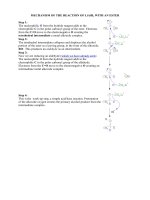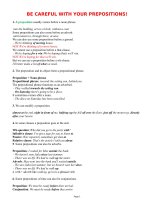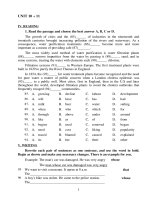POLYSACCHARIDE ESTERS WITH DEFINED FUNCTIONALISATION PATTERN
Bạn đang xem bản rút gọn của tài liệu. Xem và tải ngay bản đầy đủ của tài liệu tại đây (411.86 KB, 12 trang )
9 Polysaccharide Esters
with Defined Functionalisation Pattern
Polysaccharide esters with a defined pattern of functionalisation are indispensable
for the establishment of structure–property relations, e.g. for the solubility of cel-
lulose acetate in function of the functionalisation pattern (Chap. 8). The defined
functionalisation pattern may also yield unconventional thermal, optical and bi-
ological properties, as revealed for polysaccharide sulphuric acid half esters from
dextran and curdlan with anti-HIV [421] and cancerostatic activity [422].
A number of approaches for the preparation of polysaccharide esters with
a defined functionalisation pattern is known, applying mostly chemo- and regios-
elective synthesis and selective deacylation processes. Regioselective conversion
may be realised by protective group techniques and so-called medium controlled
reactions. However, the chemoselective functionalisation of polysaccharides has
scarcely been exploited and is of special interest for the uronic acid-containing
polymers, e.g. alginate, and for aminodeoxy polysaccharides (chitin and chitosan).
A selective esterification of the uronic acid units is discussed in Sect. 5.1.2.
The polysaccharide is transferred into the acid form and then into the tetrabuty-
lammonium salt, and finally this salt is converted homogeneously in DMSO with
long-chain alkyl bromides (see Fig. 5.5, [5]).
In the case of chitin, the tailored modification is accomplished in different
solvents (see Fig. 4.6). A number of valuable N-acetylated chitosan derivatives can
be prepared in a mixture of methanol and acetic acid (Fig. 9.1, [423,424]).
For polysaccharides containing exclusively hydroxyl groups, the modification
reactions preferably occur at primary OH groups, especially if bulky carboxylic
acid ester moieties are introduced.
A pronounced reactivity is observed for the OH groupadjacent to the glycosidic
linkage, due to electronic reasons. Consequently, for (1→4)- and (1→3) linked
polysaccharides, e.g. curdlan, starch and cellulose, the rate of esterification is
usually in the order of position 6 > 2 > 3(4). For polysaccharides with no primary
OH group, esterification at position 2 is the fastest conversion. Dextran shows
an acylation reactivity of the OH moieties in the order 2 > 4 > 3. Reaction
paths leading to alternative patterns of esterification are described in the following
sections.
170 9 Polysaccharide Esters with Defined Functionalisation Pattern
Fig.9.1. N-acyl derivativesobtained by conversionof chitosan in acetic acid/methanol with carboxylic
acid anhydrides
9.1 Selective Deacylation
Selective deacylation has been intensively studied for cellulose acetate. This is
due to the fact that partially deacetylated cellulose acetates, e.g. cellulose diac-
etate, possess adjusted solubility (compare Table 8.1, Chap. 8) and can therefore
be easily processed. The extent to which the polymer properties are controlled
by the distribution of substituents within the RU is unknown. These properties
may be additionally influenced by the distribution along the chain. Nevertheless,
deesterification is used for the preparation of polysaccharide esters with uncon-
ventional functionalisation pattern within the RU. Polysaccharide acetates with
adjusted functionalisation are valuable intermediates for the subsequent derivati-
sation, which leads (after adequate saponification) to subsequent derivatives with
inverse functionalisation pattern. Cellulose triacetate is most commonly saponi-
fied directly (see Chap. 4). The hydrolysis is performed with aqueous H
2
SO
4
and
cleaves the primary hydroxyls that can later be reesterified [425, 426].
Different functionalisation patterns are obtained under different hydrolysis
conditions [151]. For acidic hydrolysis of cellulose triacetate to products with DS
values down to 2.2, the rate of deacetylation in position 6 and position 2 is compa-
rable. If hydrolysis continues, deacetylation in position 2 is more pronounced, i.e.
the acetyl functions in 6 are the most stable [89,427]. Deacetylation in position 3 is
the fastest (Fig. 9.2A). A different behaviour is observedif the hydrolysis with acetic
acid/sulphuric acid is carried out directly after the complete functionalisation of
cellulose. The rate of reaction is comparable for all three positions over the whole
range of DS (Fig. 9.2B). Thus, cellulose acetate samples with an even distribution
of substituents on the level of the AGU are obtained.
9.1 Selective Deacylation 171
Fig. 9.2. Functionalisation pattern of differently prepared cellulose acetate samples as plot of the
partial DS at positions 2, 3 and 6 versus the overall DS. Samples prepared via A acidic deesterification
of cellulose triacetate and B acidic deesterification of cellulose triacetate directly after acetylation in
N-ethylpyridinium chloride (reproduced with permission from [151], copyright Wiley VCH)
Even more pronounced is the preferred deacylation at the secondary positions
for basic hydrolysis. Deacetylation of cellulose acetates in DMSO is achieved with
hydrazine [89] or amines [360]. Adjustment of the 6 selectivity during the deesteri-
fication is feasible by deacetylation in the ternary mixture ofDMSO/water/aliphatic
amine (e.g. dimethylamine or hexamethylenediamine). Products with high DS at
position 6, compared to the acetylation at positions 2 and 3, are obtained, as shown
in Table 9.1 [360].
The specifically substituted cellulose acetate samples obtained are applied for
the preparation of cellulose sulphuric acid half esters. The preferred functional-
isation of the secondary OH groups shows a strong influence on the properties
of the products, e.g. solubility, membrane formation, separation behaviour, and
especially in interactions with human blood [360].
Cellulose acetate phosphates with defined functionalisation pattern have been
prepared [428]. The mixed esters with phosphate moieties mainly in the positions
2 and 3 are manufactured by deacetylation of cellulose triacetates for 0.5–72 h at
20–100
◦
C with dimethylamine in aqueous DMSO. The deacetylation of cellulose
acetate of DS 2.90 gives a product with DS 0.85 and partial DS
Acetyl
of 0.05 (posi-
tion 2), 0.15 (position 3) and 0.7 (position 6). Subsequent phosphorylation with
polyphosphoric acid in DMF in the presence of tributyl amine yields cellulose
acetate phosphate with DS
Acetyl
0.83 and DS
P
1.20, which may be deacetylated by
172 9 Polysaccharide Esters with Defined Functionalisation Pattern
Table 9.1. Homogeneous deacetylation of cellulose triacetate in amine-containing media at 80 °C
(adapted from [360])
Amine Molar ratio Time DS at position
AGU Amine (h) 2 3 6
NH
2
−
(CH
2
)
6
−
NH
2
1 2.3 2.5 0.80 0.80 1.00
NH
2
−
(CH
2
)
6
−
NH
2
1 2.3 4.5 0.65 0.75 1.00
NH
2
−
(CH
2
)
6
−
NH
2
1 2.3 9.0 0.45 0.55 0.90
NH
2
−
(CH
2
)
6
−
NH
2
1 2.3 14.0 0.20 0.45 0.85
NH
2
−
(CH
2
)
6
−
NH
2
1 2.3 24.0 0.05 0.10 0.60
HN(CH
3
)
2
1 4.5 5.0 0.75 0.80 1.00
HN(CH
3
)
2
1 4.5 11.0 0.50 0.50 1.00
HN(CH
3
)
2
1 4.5 15.0 0.35 0.50 0.95
HN(CH
3
)
2
1 4.5 20.0 0.30 0.40 0.90
HN(CH
3
)
2
1 4.5 24.0 0.20 0.30 0.70
treatment with ethanolic NaOH to yield cellulose phosphate with DS
P
0.96 (partial
DS
P
of 0.77 at the secondary and of 0.19 at the primary positions).
A preferred esterification of the secondary hydroxyl groups is accomplished by
conversions in derivatising solvents as well as via hydrolytically instable interme-
diates, as discussed in Sect. 5.1.4. The advantage of this approach is that isolation
of the intermediate is not essential and the splitting of the intermediately formed
function succeeds during workup. Cellulose sulphuric acid half esters with pre-
ferred functionalisation of positions 2 and 3 are accessible by reaction with SO
3
-Py
in N
2
O
4
/DMF homogeneously (with cellulose nitrite as an intermediate [192])
or by the conversion of cellulose trifluoroacetate [188, 429] and hydrolysis of the
intermediate ester moiety.
To prepare regioselectively substituted cellulose acetate of low DS, purified
acetyl esterases are used. Certain acetyl esterases cleave off the substituent from
the 2 and 3 positions (carbohydrate esterase family 1 enzymes), whereas others
deacetylate functional groups from position 2 (carbohydrate esterase family 5 en-
zymes) or from position 3 (carbohydrate esterase family 4 enzymes) [430, 431].
Regular deacetylation along the cellulose acetate chain is performed by the treat-
ment of cellulose acetate (DS 0.9 and 1.2) with a pure Aspergillus niger acetyl
esterase from the carbohydrate esterase family 1 [432]. Prior to the structure anal-
ysis, the enzymatically obtained fragments were separated by preparative SEC.
9.2 Protective Group Technique
The regioselective conversion of polysaccharides using protective group tech-
niques is carried out with bulky ether functions such as triphenylmethyl- or silyl
ethers selectively protecting the primary hydroxyl groups. The selective and direct
protection of secondary hydroxyl groups is still an unsolved problem.
9.2 Protective Group Technique 173
9.2.1 Tritylation
The bulky triphenylmethyl moiety is one of the oldest and cheapest protecting
groups for primary hydroxyl moieties of polysaccharides. It is easily introduced by
conversion of the polysaccharide suspended in Py with trityl chloride (3 mol
/
mol
AGU) for 24–48 h at 80
◦
C. Most of the polymers dissolve during the reaction. An
exception is chitin, in which complete tritylation of the primary position is limited
and a DS of 0.75 is obtained only under rather drastic conditions (90
◦
C,72h,
10 mol reagent/mol RU, DMAP catalysis). Dissolution does not occur. Cellulose
can be homogeneously tritylated in the solvent DMAc/LiCl. The polysaccharide
trityl ethers are commonly soluble in DMSO, Py and DMF, and can be esterified
without side reactions in these solvents. Deprotection is carried out with gaseous
HCl in dichloromethane [398], aqueous HCl in THF [433] or preferably with
hydrogen bromide/acetic acid [403].
The path is demonstrated by the synthesis of 2,3-di-O-acetyl-6-mono-O-propi-
onyl cellulose (Fig. 9.3). The conversion of 6-O-triphenylmethyl cellulose with
acetic anhydride in Py yields 2,3-di-O-acetyl-6-O-triphenylmethyl cellulose, which
can be selectively detritylated with hydrogen bromide/acetic acid [403]. Subse-
quent acylation of the generated hydroxyl groups with propionic anhydride leads
to a completely modified 2,3-di-O-acetyl-6-mono-O-propionyl cellulose. Starting
with the propionylation, a product with an inverse pattern of functionalisation, i.e.
6-mono-O-acetyl-2,3-di-O-propionyl cellulose, is obtained, which is very useful
for the assignment of peaks in the NMR spectra of cellulose esters [403].
Regioselectively substituted cellulose esters, e.g. propionate diacetate-, bu-
tanoate diacetate-, acetate dipropanoate-, acetate dibutanoate of cellulose, have
been used to understand the thermal behaviour of mixed esters, compared with
cellulosetriester. DSC measurements have shown a correlation between themelting
point and the length of the acyl groups at the secondary positions [434].
The regioselectively functionalised cellulose esters form crystals that can
be studied by direct imaging of single crystals by atomic force microscopy
(Fig. 9.4, [435]). The thickness is 29 nm for 2,3-di-O-acetyl-6-mono-O-propionyl
cellulose and 45 nm for 6-mono-O-acetyl-2,3-di-O-propionyl cellulose. The dy-
namic structures formed in polar solvents of regioselectively substituted cellulose
ester samples can be compared with those of commercial cellulose esters with
random distribution, revealing large differences in the chain conformation, the
solubility, and the clustering mechanism and structures [436, 437].
Protection of polysaccharides is very efficient with methoxy-substituted trityl
moieties. It increases both the rate of conversion towards the protected polysaccha-
ride and the rate of the deprotection step [433]. This is illustrated for the synthesis
of protected cellulose in DMAc/LiCl (Table 9.2). In view of the pronounced se-
lectivity, the stability of the protected cellulose, the selective detritylation and
the price, protection with 4-monomethoxytrityl chloride is recommended.
13
C
NMR spectroscopy is used to confirm the purity of the 4-monomethoxytrityl pro-
tected cellulose (Fig. 9.5). Complete detritylation of the protected polysaccharide
is achieved with aqueous HCl in THF for 7 h.









